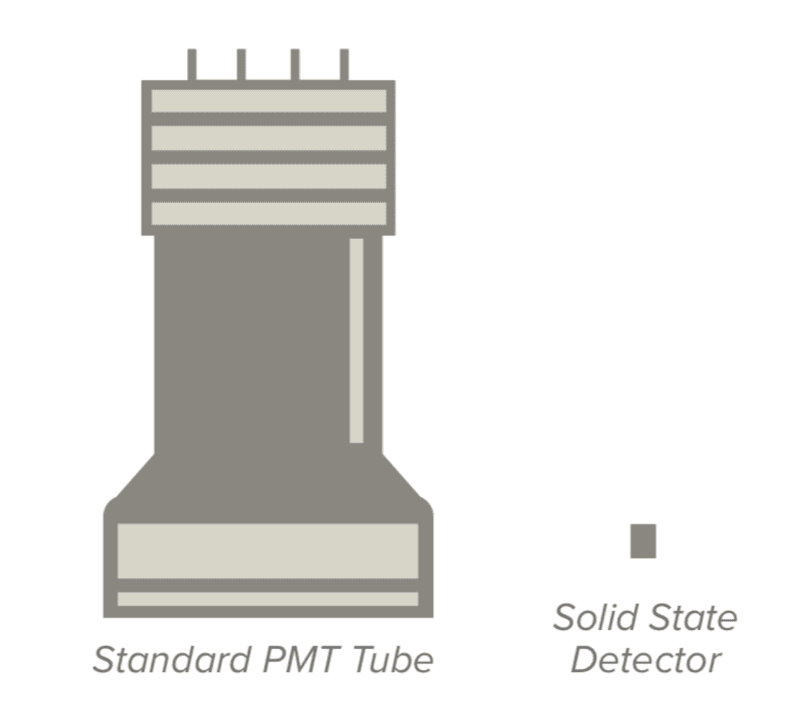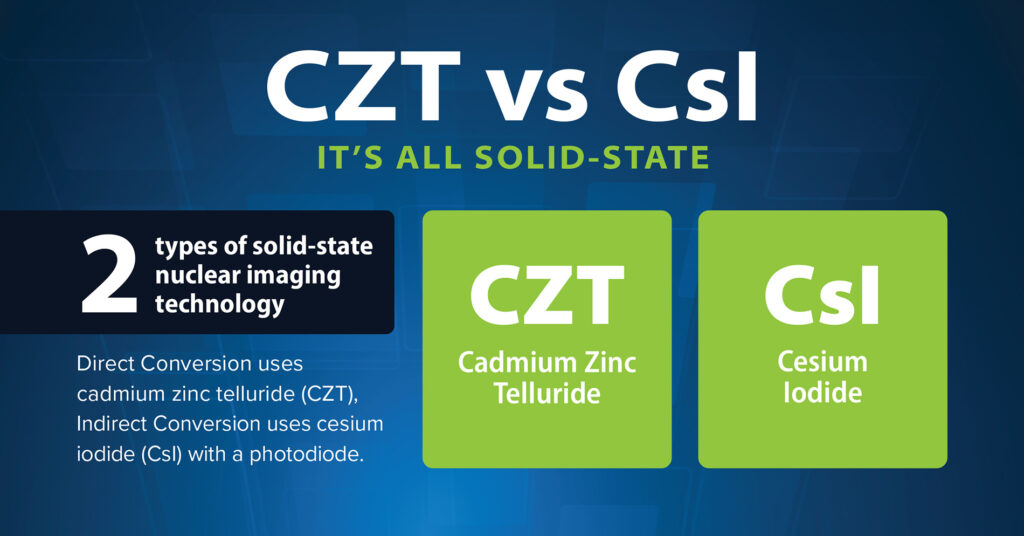Signal detectors are a key component of any medical imaging technology. Many gamma cameras still in use today utilize technology that is more than 50 years old – the Anger-based analog technology. However, more modern options are available with solid state technology.
Solid state comes in two main formats: either CZT or CsI. There is often confusion about what each involves and whether one is better than the other. Are there any significant advantages or disadvantages? Let’s take a closer look:
What is solid state imaging?
First of all, let’s go back to what was in use for SPECT imaging prior to the development of solid state. Most used Anger-based technology (developed by Hal Anger), which is more than 50 years old. In many areas today, Anger technology is still being used, while others have updated to solid state cameras.
Anger technology is an analog model that uses vacuum tubes and hygroscopic sodium iodide (NaI) crystals in the detector heads. In fact, due to the technology used, one of the obvious visual differences you’ll notice between an Anger detector head and a solid state detector head is the size of them. Analog heads take up a lot more room and can weigh up to 600 lbs, whereas a solid state head weighs between 25 and 90 pounds.

Solid state imaging is classified by the absence of vacuum tubes, and replaces antiquated photomultiplier tubes (PMTs) with segmented crystals and semiconductors. The major advantage of these cameras is that they can determine locations with complete certainty. They accomplish this by pixelating the camera’s detector head into tiles instead of a continuous sheet of tubes.
To locate the event using analog technology the data has to be “summed” by a software application. This can be time consuming and delay the performance of scatter correction. Solid-state technology uses a pixelated detector that identifies exactly where the gamma ray photon is emitted from. In this way, solid state has the advantages of better sensitivity and high energy resolution.
Solid-state technology allows for lower levels of radiation to be used in imaging. Another benefit is that attenuation correction can be performed using the same detectors for both the transmission and emission in a single sitting, thereby reducing scan time. This helps to create a better experience for the patient and a more efficient operation for the imaging facility.
There are two types of solid state nuclear imaging technology: direct conversion, which uses cadmium zinc telluride (CZT); and indirect conversion, which uses cesium iodide (CsI) with a photodiode.
The differences between CZT and CsI
The first thing to know about both types of solid state technology is that they produce a higher quality image than Anger technology. The technology is also smaller and more lightweight, can be deployed in both fixed and mobile situations (Anger remains fixed), and can deliver a better patient experience.
Solid-state nuclear cameras offer significant advantages over Anger-based cameras. This state-of-the-art technology continues to revolutionize nuclear imaging and provide patients with the highest level of diagnostic confidence.
Those are the overall benefits of solid state over Anger SPECT imaging, but what about the differences between the two types of solid state technology?

Configuration
CZT imaging takes a couple of different forms. In one design, pixelated CZT detector arrays are mounted in nine vertical columns and placed in 90 degree gantry geometry. Each column consists of an array of 1024 CZT elements, 2.46 x 2.46 x 5mm thick, arranged in 16 x 64 element array. This has an approximate size of 40 x 160mm.
Another configuration for CZT uses a round CZT crystal, producing an asymmetric CZT energy response. This has been found to reduce scatter by 30% for fixed energy acceptance windows.
CsI is used in a two or three detector configuration. Each detector head contains an array of 768 6.1 x 6.1 x 6mm CsI crystals coupled to individual silicon photodiodes. These are used to convert the light output of the crystals to electrical pulses, then digital logic and software are used to process the signals. For example, the Digirad X-ACT+ camera uses CsI photodiode and employs triple head cardio-centric imaging.
Direct and indirect conversion
Many solid-state SPECT cameras look very similar on the outside, but compare their individual design, functionality, features and cost and you’ll note several differences, including the conversion.
CZT works by direct conversion, while CsI uses indirect conversion using photodiodes. One of the major differences is the cost of the materials involved for doing this. CZT is significantly more expensive to produce than CsI.
There are claims that CZT is ten times more sensitive than NaI/PMT. However, in actual practice, a CZT camera’s photopeak detection efficiency is only 64% of either NaI/PMT or CsI/Photodiode.
This poor intrinsic peak efficiency is due to a common problem in direct conversion solid state detectors called hole tailing. The resulting loss of sensitivity means that the energy window must be set wider than necessary for the specified energy resolution to recover the lost photopeak counts. Additionally, there is no improvement in scatter rejection with CZT, resulting in higher costs and reduced precision.
By comparison, CsI doesn’t suffer from hole tailing as conversion is indirect.
Is one better than the other?
At the very least, both CsI and CZT produce high-quality imaging that is a vast improvement on the old Anger technology. You could argue that it depends on the individual machine, the features it has and what you actually need it for.
One area where CsI tends to outperform CZT is in attenuation correction. The moving columns of CZT present a higher risk of truncation. Many machines don’t have any in-built process to identify and correct for soft tissue artifacts in SPECT images.
Final thoughts
The key differences between a CZT gamma camera and CsI really lie with the conversion technology. While CZT utilizes direct conversion, CsI uses indirect conversion with the aid of photodiodes.
As solid state imaging technologies, both produce high quality images that are a vast improvement over the old Anger-based technology. The equipment is more compact and lightweight and scanning can be done more quickly, making them good options for mobile imaging.
Here at Digirad, we use solid state detectors. Optimized with CsI and Digirad’s patented photodiode, they offer the following benefits:
- They produce high quality, solid state imaging.
- They are much lighter and more compact, providing the ability to create new gantry designs for rapid imaging.
- They can acquire both SPECT and CT, requiring only one gantry.
- CsI/photodiode is more affordable than CZT because it is less expensive to produce the material.
These benefits allow us to offer superior imaging quality at a lower cost.




